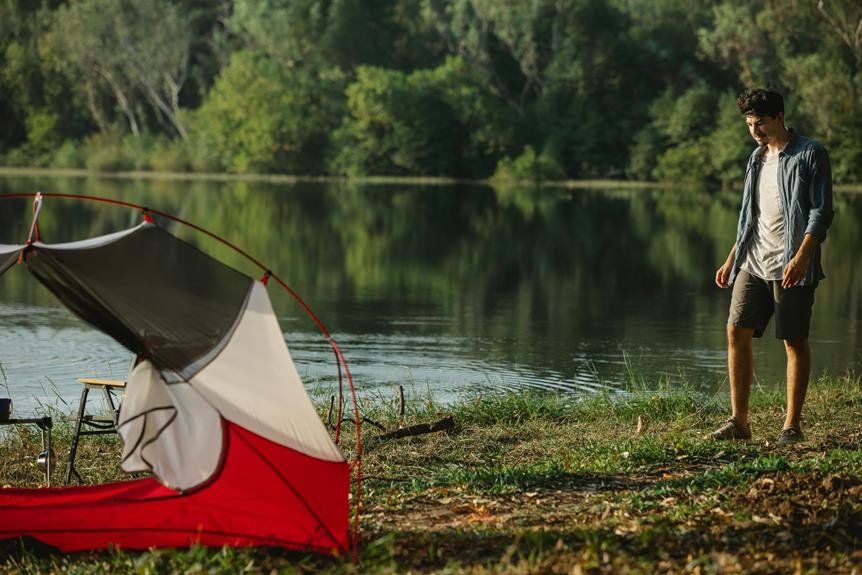
When seeking eco-friendly camping clothing, navigating the plethora of options can feel overwhelming. Understanding which fabrics are sustainable and how to evaluate certifications is key. But there's more to it than just the material – ethical production practices and durability play crucial roles in making environmentally conscious choices. So, before you venture into the wilderness, equip yourself not just with gear, but also with the knowledge to make mindful decisions that benefit both you and the environment.
Understanding Eco-Friendly Fabric Options
When choosing eco-friendly camping clothing, opt for fabrics that minimize environmental impact and promote sustainability. Look for materials like organic cotton, hemp, bamboo, and recycled polyester. Organic cotton is grown without harmful pesticides or chemicals, reducing water usage and preventing soil contamination. Hemp is a versatile and durable fabric that grows quickly without the need for pesticides or excessive water. Bamboo is a fast-growing, renewable resource that requires minimal water and no pesticides to thrive. Recycled polyester is created from post-consumer plastic bottles, reducing waste and energy consumption.
Consider the production process of the fabrics as well. Look for clothing made using environmentally friendly practices such as low-impact dyes, water recycling systems, and ethical labor practices. By choosing fabrics that prioritize sustainability throughout their lifecycle, you can minimize your environmental footprint while enjoying the great outdoors.
Make informed decisions by researching brands that prioritize eco-friendly materials and transparent manufacturing processes.
Evaluating Sustainability Certifications
To further ensure the eco-friendliness of your camping clothing choices, it's important to assess the sustainability certifications associated with the fabrics and brands you're considering. Sustainability certifications serve as proof that the clothing items have met certain environmental standards throughout their production process. Look for certifications like Global Organic Textile Standard (GOTS), OEKO-TEX Standard 100, Bluesign, or Fair Trade Certified. These certifications indicate that the clothing is made from organic materials, is free from harmful substances, has been produced using environmentally friendly processes, or ensures fair labor practices.
When evaluating sustainability certifications, take the time to research what each certification entails and how stringent their criteria are. Some certifications may focus on specific aspects of sustainability, such as organic farming practices or water usage reduction. By understanding the different sustainability certifications, you can make informed decisions about which camping clothing items align best with your eco-friendly values.
Researching Ethical Production Practices
For a comprehensive approach to selecting eco-friendly camping clothing, delve into researching ethical production practices. When researching ethical production practices, look for brands that prioritize transparency in their supply chain. Seek out companies that provide information about where their materials are sourced, how their workers are treated, and what steps they take to minimize environmental impact during production.
Look for certifications such as Fair Trade or Global Organic Textile Standard (GOTS) to ensure that the clothing you choose meets specific ethical standards. Consider brands that support local communities, use sustainable manufacturing processes, and aim to reduce waste in their production facilities.
Considering Functionality and Durability
To ensure your eco-friendly camping clothing meets your needs, prioritize functionality and durability when making your selection. When choosing your camping attire, consider the activities you'll engage in and the environment you'll be in. Look for clothing that offers features like moisture-wicking properties to keep you dry, UV protection for sunny days, and insect repellent finishes for bug-prone areas. Opt for versatile pieces that can adapt to changing weather conditions, such as convertible pants that turn into shorts or jackets with removable layers.
Durability is key for outdoor adventures, so select clothing made from high-quality, long-lasting materials like organic cotton, hemp, or recycled polyester. Reinforced stitching, strong zippers, and abrasion-resistant fabrics can enhance the longevity of your garments. Check for reviews or ratings on the brand's reputation for durability to ensure your clothing can withstand the rigors of camping trips. By prioritizing functionality and durability, you can invest in eco-friendly camping clothing that not only benefits the environment but also meets your practical outdoor needs.




